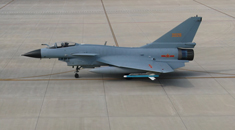China conducted a land-based, mid-course missile interception test within its territory on the evening of June 19, 2022, and the test had achieved the desired test objective, the Defense Ministry said. The test is defensive in nature and not targeted against any country.
At present, only a few countries have mastered the mid-course anti-missile interception technology. The technology is targeted at are the medium and long-range ballistic missiles and intercontinental ballistic missiles, which are the most used nuclear weapons.
It has been 12 years since China's first ground-based mid-course anti-missile interception test. During the 12 years, many countries have been developing their own medium and long range ballistic missiles, and there was even a momentum of "missile race" and "hypersonic race" in some regions. The combination with hypersonic glide vehicles also makes medium and long-range ballistic missiles more difficult to intercept.
Of course, China's mid-course anti-missile interception system will be iteratively upgraded based on real threats. At present, the entire equipment system of China's land-based mid-course anti-missile interception can not only restrain medium and long-range ballistic missiles with simple penetration capabilities but may also be able to effectively deal with various new threats including hypersonic aircraft.
It is worth noting that the Chinese Ministry of Defense pointed out in the news that this test is defensive and is not aimed at any country. This is in stark contrast to some countries represented by the US.
In the field of international arms control, the US and other countries wantonly "break the contract and withdraw from treaties", seriously undermining the international strategic balance and mutual trust. At the same time, they also make frequent moves in the development of nuclear weapons delivery vehicles, including a new generation of intercontinental missiles. They also attempt to deploy medium-range weapons in other countries and even push anti-missile systems such as Terminal High Altitude Area Defense (THAAD) and the land-based Aegis Ashore missile defense system to the door of China.
The success of China’s land-based mid-course anti-missile interception test is of great significance in terms of maintaining the stability of the regional and world order. It fully proves that China has deep and solid technology accumulation, a complete and reliable equipment system in this field, and has achieved a considerable level of actual combat. This is undoubtedly a very effective containment for those forces who would wantonly wield the "nuclear stick" and intend to carry out "nuclear adventures".
In addition, China is very timely and fast when it comes to releasing relevant news about the land-based mid-course anti-missile interception test that was released overnight on the day of the test. This transparent and candid attitude fully reflects China's responsibilities as a responsible major country and is a powerful response to the US and the West's accusations of "opaqueness" in China's national defense.
Just two days before the ground-based mid-course anti-missile interception test, the Chinese navy's first catapult-type aircraft carrier Fujian was officially launched. If the aircraft carrier is the spear, then the mid-course anti-missile defense is the shield. These two major national defense science and technology achievements are based on China's own strength. There is no doubt that this is something that Chinese people are proud of.
Editor's note: This article is originally published on cankaoxiaoxi.com, and is translated from Chinese into English and edited by the China Military Online. The information, ideas or opinions appearing in this article do not necessarily reflect the views of eng.chinamil.com.cn.















